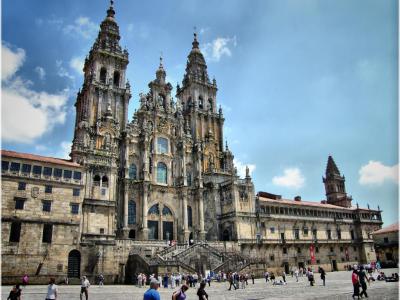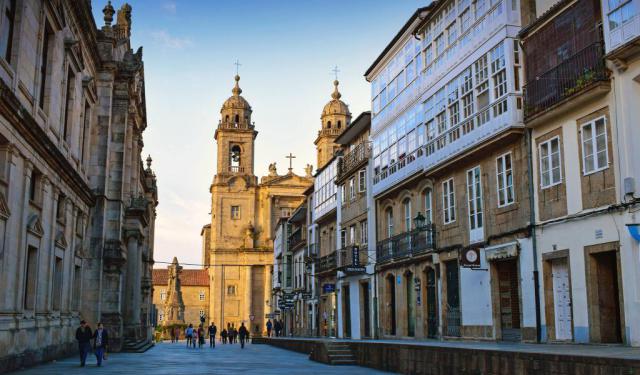
Santiago de Compostela Cathedral, Santiago de Compostela (must see)
The Santiago de Compostela Archcathedral Basilica holds great significance as a religious and historical landmark. It is an integral part of the Metropolitan Archdiocese of Santiago de Compostela and forms a vital component of the Santiago de Compostela World Heritage Site.
The cathedral is renowned as the reputed burial place of Saint James the Great, one of the apostles of Jesus Christ. It stands as one of the few remaining churches in the world constructed directly above the tomb of an apostle, sharing this distinction with notable churches such as Saint Peter's Basilica in Vatican City, Saint Thomas Cathedral Basilica in Chennai, India, and the Basilica of Saint John in Izmir, Turkey.
Throughout history, the arch cathedral basilica has been a prominent pilgrimage site along the Way of Saint James since the Early Middle Ages. Pilgrims from various parts of the world embark on this pilgrimage route, and the cathedral serves as the traditional endpoint of their journey. The spiritual significance of this place and the devotion associated with Saint James have attracted countless pilgrims, making Santiago de Compostela a renowned destination for religious travelers.
Architecturally, the cathedral is a remarkable example of Romanesque design, with subsequent additions in the Gothic and Baroque styles. Its grandeur and architectural beauty captivate visitors as they explore its various facets.
Each of the cathedral's façades, along with their adjacent squares, forms expansive urban squares that contribute to the city's charm. The Baroque façade of Praza do Obradoiro square, completed by Fernando de Casas Novoa in 1740, is a notable highlight. Another Baroque-style façade, the Acibecharía façade, originally designed by Ferro Caaveiro and Fernández Sarela, underwent modifications by Ventura Rodríguez.
The Pratarías façade, constructed by Master Esteban in 1103, showcases the architectural legacy of the Romanesque era. However, the most significant and revered artistic masterpiece of the cathedral is the Pórtico da Gloria. Created by Master Mateo in 1188, this early Romanesque sculpture is a testament to the skill and artistry of its time.
The cathedral is renowned as the reputed burial place of Saint James the Great, one of the apostles of Jesus Christ. It stands as one of the few remaining churches in the world constructed directly above the tomb of an apostle, sharing this distinction with notable churches such as Saint Peter's Basilica in Vatican City, Saint Thomas Cathedral Basilica in Chennai, India, and the Basilica of Saint John in Izmir, Turkey.
Throughout history, the arch cathedral basilica has been a prominent pilgrimage site along the Way of Saint James since the Early Middle Ages. Pilgrims from various parts of the world embark on this pilgrimage route, and the cathedral serves as the traditional endpoint of their journey. The spiritual significance of this place and the devotion associated with Saint James have attracted countless pilgrims, making Santiago de Compostela a renowned destination for religious travelers.
Architecturally, the cathedral is a remarkable example of Romanesque design, with subsequent additions in the Gothic and Baroque styles. Its grandeur and architectural beauty captivate visitors as they explore its various facets.
Each of the cathedral's façades, along with their adjacent squares, forms expansive urban squares that contribute to the city's charm. The Baroque façade of Praza do Obradoiro square, completed by Fernando de Casas Novoa in 1740, is a notable highlight. Another Baroque-style façade, the Acibecharía façade, originally designed by Ferro Caaveiro and Fernández Sarela, underwent modifications by Ventura Rodríguez.
The Pratarías façade, constructed by Master Esteban in 1103, showcases the architectural legacy of the Romanesque era. However, the most significant and revered artistic masterpiece of the cathedral is the Pórtico da Gloria. Created by Master Mateo in 1188, this early Romanesque sculpture is a testament to the skill and artistry of its time.
Want to visit this sight? Check out these Self-Guided Walking Tours in Santiago de Compostela. Alternatively, you can download the mobile app "GPSmyCity: Walks in 1K+ Cities" from Apple App Store or Google Play Store. The app turns your mobile device to a personal tour guide and it works offline, so no data plan is needed when traveling abroad.
Santiago de Compostela Cathedral on Map






Sight Name: Santiago de Compostela Cathedral
Sight Location: Santiago de Compostela, Spain (See walking tours in Santiago de Compostela)
Sight Type: Religious
Guide(s) Containing This Sight:
Sight Location: Santiago de Compostela, Spain (See walking tours in Santiago de Compostela)
Sight Type: Religious
Guide(s) Containing This Sight:
Walking Tours in Santiago de Compostela, Spain
Create Your Own Walk in Santiago de Compostela
Creating your own self-guided walk in Santiago de Compostela is easy and fun. Choose the city attractions that you want to see and a walk route map will be created just for you. You can even set your hotel as the start point of the walk.
Santiago de Compostela Introduction Walking Tour
Legend has it that after Saint James, one of the Twelve Apostles of Jesus, was martyred in Jerusalem in 44 AD, his followers carried his decapitated body by sea to Spain. Others claim that the saintly remains were miraculously taken up by angels and sailed to the coast of Galicia, where a massive rock closed around it and was later moved to its final resting place.
Either way, during the... view more
Tour Duration: 2 Hour(s)
Travel Distance: 1.7 Km or 1.1 Miles
Either way, during the... view more
Tour Duration: 2 Hour(s)
Travel Distance: 1.7 Km or 1.1 Miles

